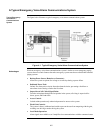
4-2
The figure below illustrates a typical emergency voice/alarm communications system:
Figure 4-1. Typical Emergency Voice/Alarm Communications System
While an emergency voice/alarm communications system is similar to a non-emergency paging
system, there are certain features that make emergency systems much more reliable than standard
paging systems:
• Backup Power Source (Batteries or Generator):
Allows the system to operate for as long as several days during a power failure.
• Dedicated Power Feed:
Isolates fire alarm power circuits from other branch circuits, preventing a fault from a
non-alarm circuit causing a fault at the fire alarm.
• Supervision of All Critical Signal Paths:
From the microphone through the last speaker in the system, all wiring is supervised for
shorts, opens, and Earth faults.
• Access Control:
Locked cabinet permits only authorized personnel to access to the system.
• Fixed Gain Controls:
The system is factory calibrated and sealed to prevent the user from tampering with the gain,
avoiding over-driving or under-driving the system.
• Local Mode Operation:
Alarm signals are available even if amplifiers lose communications with the command center.
A Typical Emergency Voice/Alarm Communications System
Advantages
Typical Emergency
Voice/Alarm
Communications
System


















